Faintly bitter, and wonderfully spiced Methi Thepla are savory flatbreads that are delicious to enjoy as a delicious snack any time of the day. My step-by-step instructions with photos and video will show you how to easily make this classic Thepla recipe with fresh fenugreek leaves and whole wheat flour. Plus, get tasty suggestions for some sides to eat with Methi Thepla!
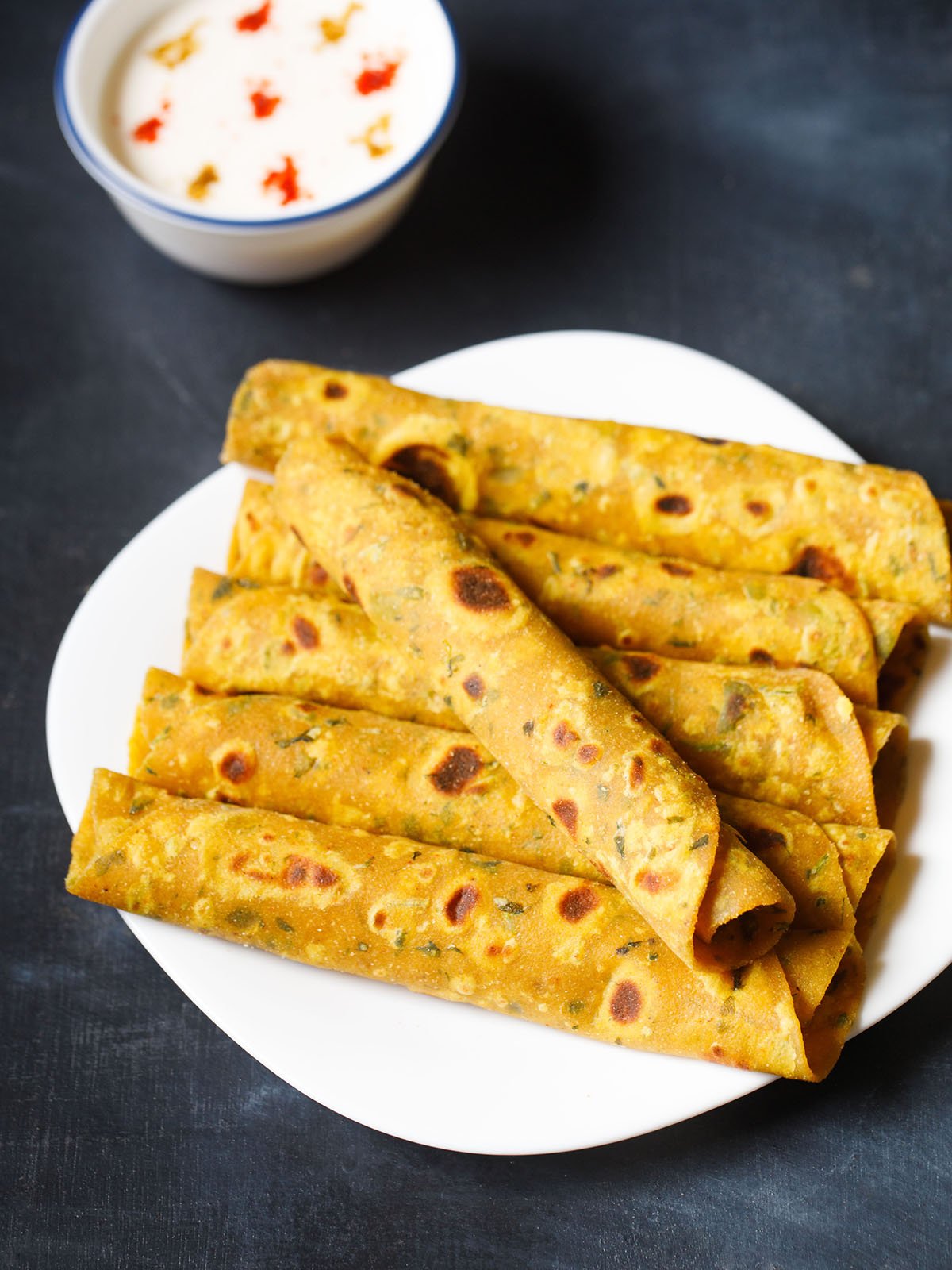
About Thepla Recipe
Thepla are flavorful flatbreads that are made with spices, herbs, yogurt, whole wheat flour, gram flour and optionally millet flours with or without the inclusion of greens or veggies.
Methi thepla is made with fresh fenugreek (methi) leaves and whole grain flours. These leaves are slightly bitter with a hint of maple, and smell fantastic both raw and when cooked.
Fenugreek also happens to be quite healthy and is known for helping to reduce inflammation and blood sugar levels.
When combined with spices and a blend of whole wheat flour, gram flour, sorghum flour, and pearl millet flour, the deep earthy taste of the methi is beautifully balanced.
The multigrain thepla dough is then flattened and lightly roasted to create tender and soft flatbreads that are delicious as a snack or fun side dish.
Methi thepla pair well with nearly any savory or sweet dipping sauce, mango pickle, or creamy yogurt. Continue reading for easy steps and tips (plus video!) for making the best multigrain thepla recipe with fenugreek!

How do you store fenugreek leaves?
As soon as they are purchased and home you should pluck the leaves from the fenugreek stems. Then thoroughly wash and dry the leaves, and keep them in an airtight container or a zip lock bag in the fridge.
I like to keep the plucked methi leaves in a steel container, and the leaves stay fresh for 4 to 5 days. Then whenever I want I can add a sprinkling of methi leaves to pakoras or pulao and even dal.
For more advice for properly cleaning methi be sure to read this Aloo Methi recipe post!
How to make Methi Thepla Recipe
Prep Methi Leaves
Before you begin making thepla recipe, you have to prep the methi leaves and make the dough. Pluck the leaves from the stems and tightly pack them in a measuring cup of 240 or 250 ml. Only use the leaves and not the stems.
1. First prepare the fenugreek: Rinse 1 cup of methi leaves very well in cool running water. Then drain them thoroughly and dry with a kitchen towel or paper towel. Chop the leaves finely and set them aside.
Tip: You need to finely chop the methi leaves. If not finely chopped, you will find it difficult to roll the dough and the leaves may tear the dough when rolling.

Make Thepla Dough
2. In a large mixing bowl, add the following listed flours:
- 1 cup of whole wheat flour
- ¼ cup besan or gram flour – you can replace it with chickpea flour
- ¼ cup of pearl millet flour also known as bajra atta in Hindi
- ¼ cup sorghum flour called jowar flour or jowar atta
Note that if you don’t have or prefer not to use millet flour – simply leave out and instead add 1¼ cups of whole wheat flour and ½ cup of besan flour.
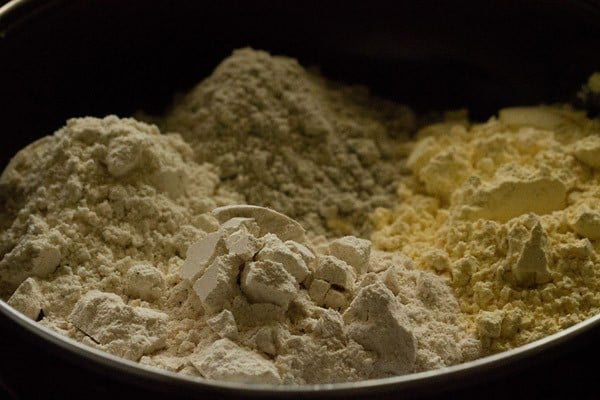
3. Next, add the spices and herbs:
- 1-inch ginger, grated or crushed (in a mortar-pestle)
- 1 or 2 green chilies, crushed – about ½ to 1 teaspoon chopped green chilies or serrano pepper
- ½ teaspoon red chili powder or cayenne pepper
- ½ teaspoon turmeric powder
- ½ teaspoon cumin powder
- ½ teaspoon coriander powder
- ¾ teaspoon salt or add as required
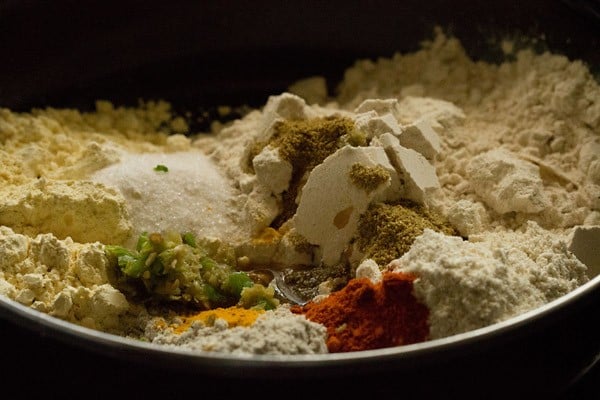
4. Now add the chopped methi leaves.
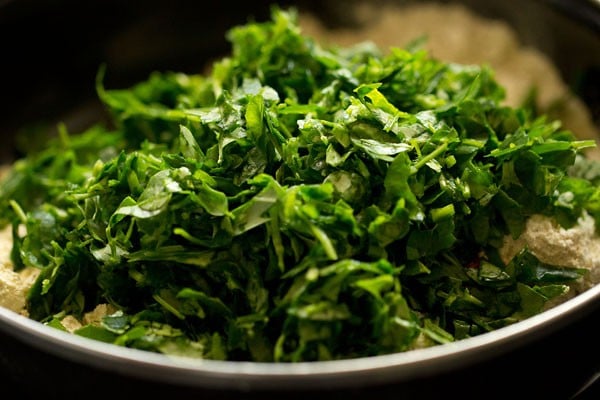
5. Mix everything well.
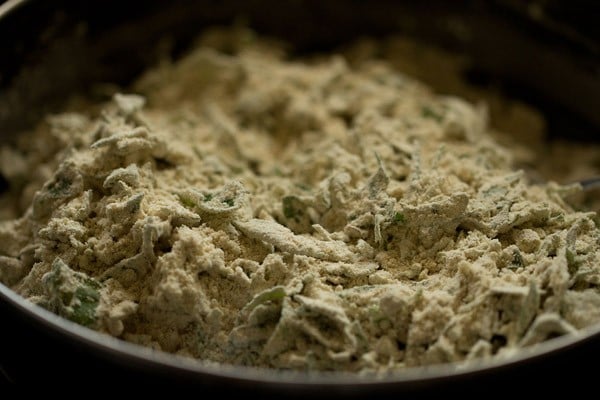
6. Next add 4 to 5 tablespoons of curd or yogurt. To make a vegan thepla add 4 tablespoons of water or vegan yogurt instead.
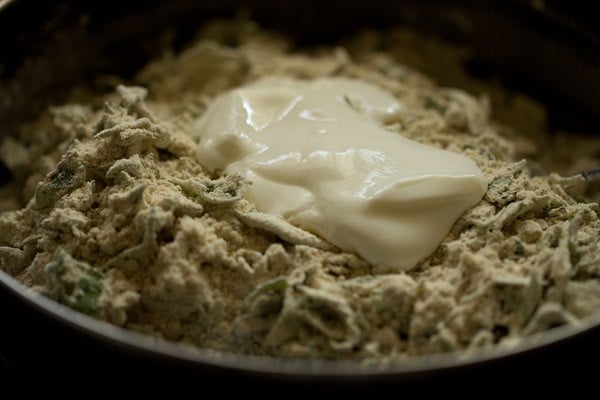
7. Mix again and knead into a dough. Do not add any additional water while kneading, as the methi leaves release water.

8. Knead very well to form a soft, smooth dough. You can add more curd a tablespoon at a time if required while kneading.
Tip: If the dough looks hard, add a few tablespoons of curd and knead. If the dough becomes sticky, add some wheat flour. Mix and continue to knead.
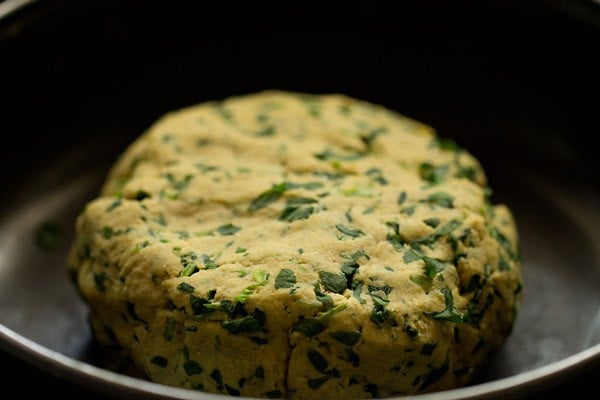
9. Now make 10 or 11 medium sized balls from the dough.

Roll Into Flatbreads
10. Working one at a time, take a thepla dough ball and lightly sprinkle with flour on a clean, lightly floured surface.
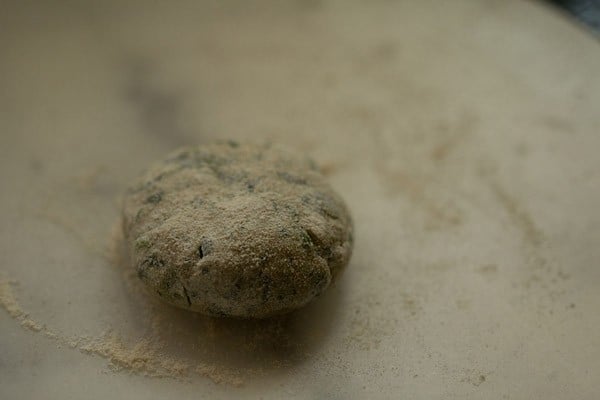
11. Use a rolling pin to flatten.
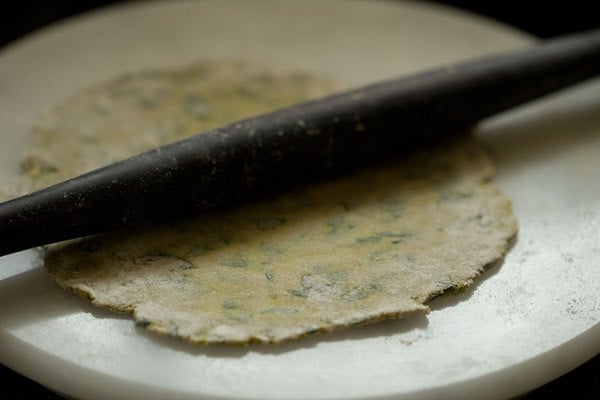
12. Roll the thepla to a round flatbread of about 5 to 6 inches in diameter.

Cook Methi Thepla
13. Heat a tawa or large skillet over medium-high heat. Once hot, place the flattened thepla onto the surface.
Let cook for under a minute until just starting to become light golden or you see faint air pockets on the top.
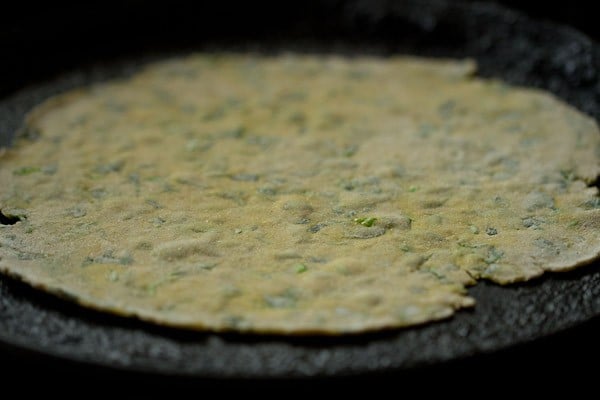
14. Use a spatula to flip.

15. Spread oil lightly on the top side to coat, like in the picture below.
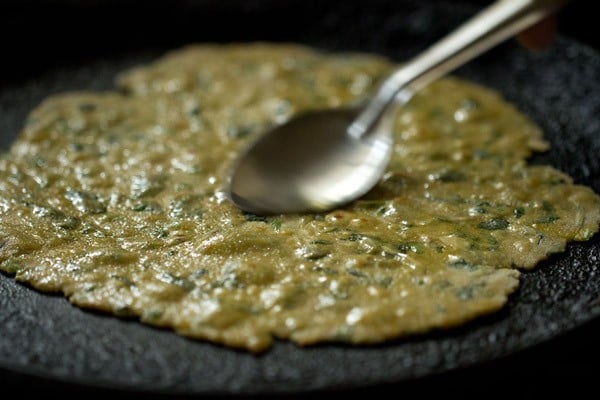
16. Flip the thepla again when the second side is half-cooked.
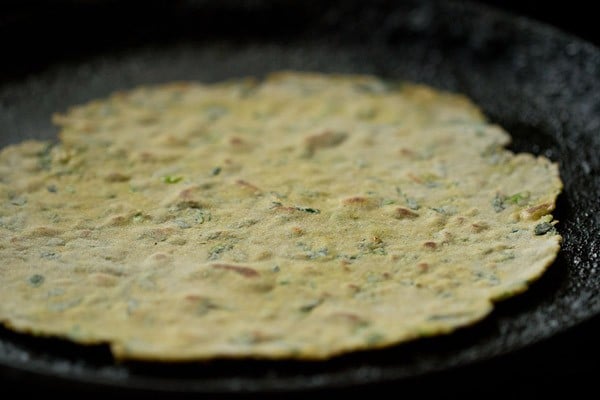
17. Now spread a bit of oil on this side, too.
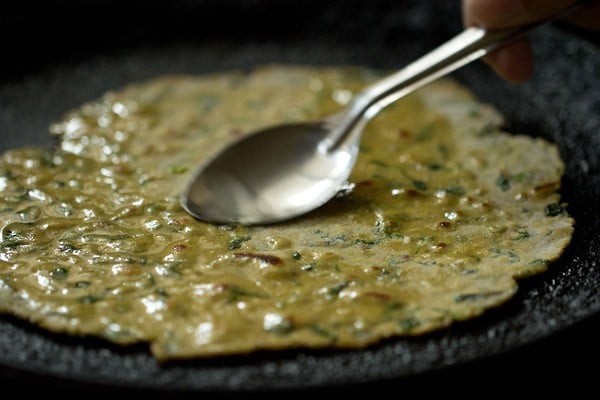
18. Continue to flip back and forth a couple of times, allowing the thepla to cook for just under a minute or so each time until the flatbread becomes golden brown with even, slightly darker brown spots.
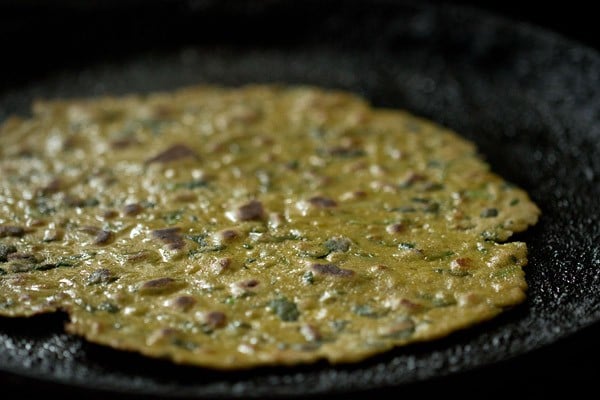
19. If needed you can press methi thepla with spatula to get an even cook.
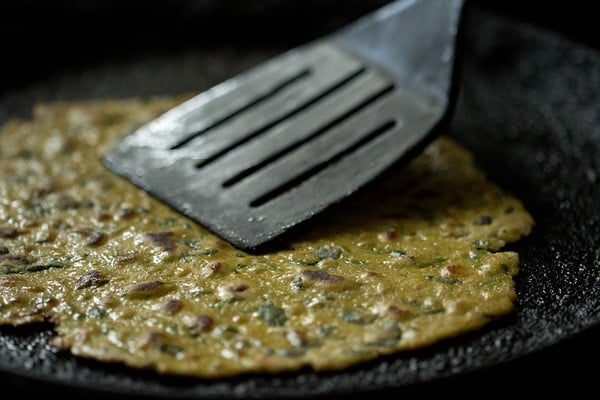
20. Note: Since I plan to serve them after a few hours, I have added a good amount of oil so that they remain soft. If you plan to serve them immediately then you can add less oil.
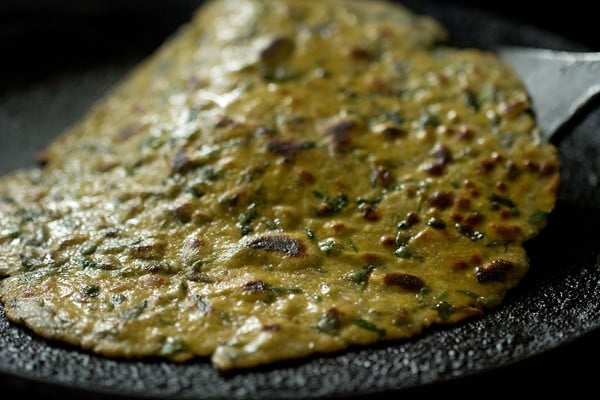
21. Remove the thepla from the skillet, and keep transfer to a roti basket or a covered platter to serve. Continue to make all thepla this way.
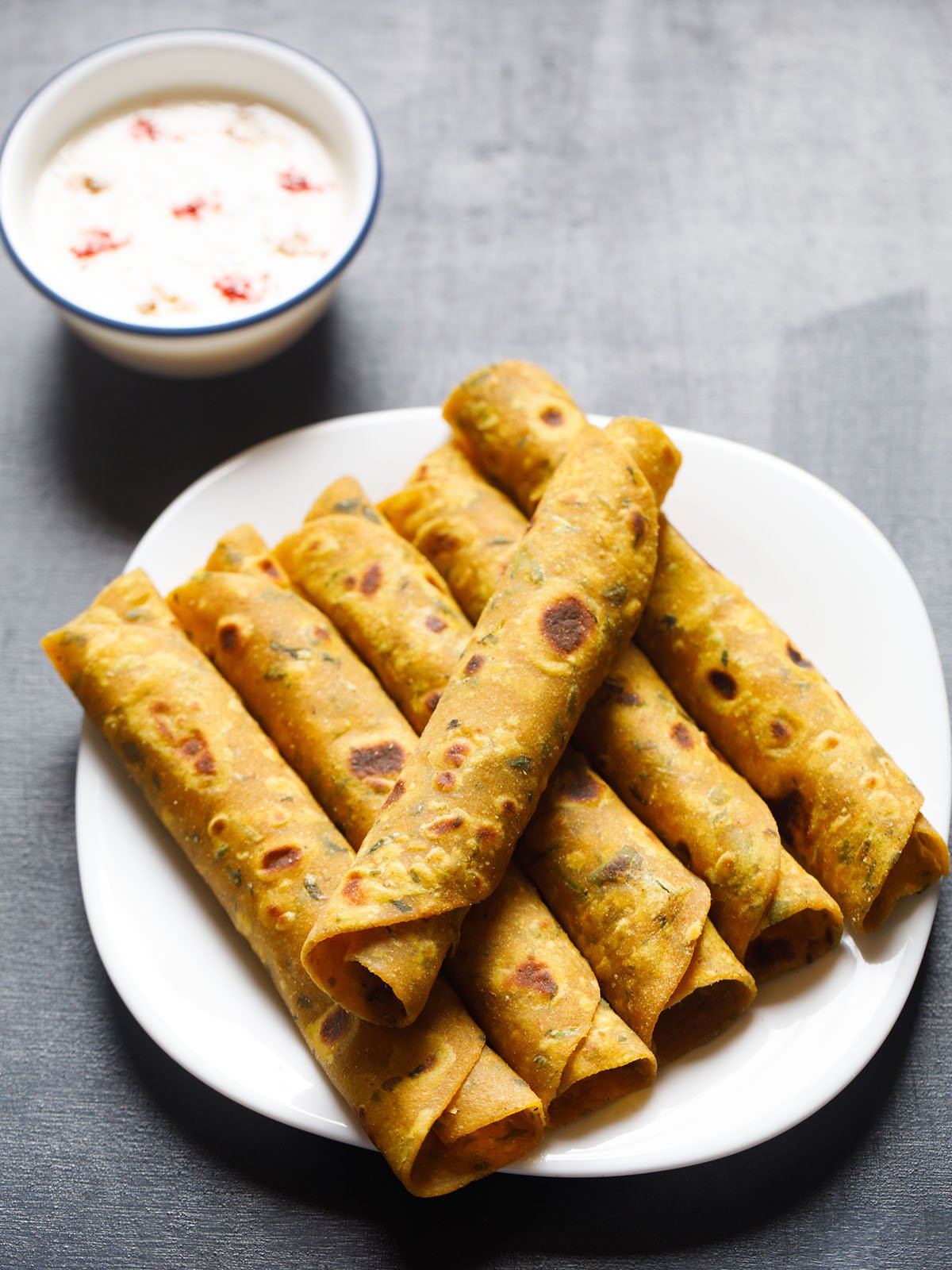
Serving Suggestions
Serve Methi Thepla with plain curd (yogurt), lemon or Mango Pickle, Mango Chutney, or Mango Chunda. The bitterness from the fenugreek pairs perfectly with the sweetness of the mango!
You can also eat these with a simple Batata nu Shaak. Methi thepla also pairs well as a side snack with Masala Chai. I also love to eat it with Dal Fry.
How do you store Methi Thepla?
Methi thepla are best when enjoyed either right away or later the same day. They will keep well for up to 3 to 4 days when you make them without curd.
So if you want to have them later after a few days, do not add curd as it will lessen its shelf life. Simply knead the dough with water. Store cooled flatbreads in an airtight container and keep at room temperature.
They also freeze well. Simply wrap a stack of cooled methi thepla in foil before storing in an airtight freezer bag, and keep in the freezer for up to 3 months.
Thaw in the fridge and later reheat these flatbreads either in a skillet on the stove or in the oven for just a few minutes until warm.
Variations
There are many variations of making thepla recipe and each family has their own method and proportions of flours that they add. Make a plain thepla recipe or add a few veggies that make them healthier. I have shared a few thepla recipe variations and have listed them below.
- Lauki Thepla: I make these soft flatbreads with bottle gourd (opo squash, calabash). My lauki thepla recipe is different from methi thepla wherein I do not include millet flours but only add whole wheat flour and gram flour.
- Mooli Thepla: These rustic flatbreads made with tender white radish, whole wheat flour and spices are simply delicious. Both mooli thepla and mooli paratha are different unique recipes. To make mooli thepla mix the radish with the flour and then knead to a soft dough. But to make paratha, you stuff the grated radish as a separate layer in the rolled dough.
- Plain Thepla: Make the simplest version of plain thepla recipe without any vegetables. Omit fenugreek leaves in this recipe. Add some water to knead the dough. You can also omit the millet flours and include 1½ cups of whole wheat flour and ¼ cup of gram flour.
- With Kasuri Methi: We call dried fenugreek leaves ‘Kasuri Methi’ in Hindi. These dried aromatic leaves come in handy when you do not have fresh leaves. You can substitute fresh methi leaves with Kasuri Methi in this recipe – simply add about 2 to 3 tablespoons. Add some water as needed while kneading.
- Other Greens: You can make this thepla recipe with green leafy vegetables like spinach or amaranth leaves.
Expert Tips
- Flours: You can include various combinations of flours with different ratios. However, always add more whole wheat flour. With lesser amounts of wheat flour, your thepla can become chewy or hard and you won’t be able to roll the dough easily. A relevant point to be remembered is not to increase the amount of gram flour (besan) too much. This can make your methi thepla hard and dry.
- Dough consistency: The thepla dough has to be smooth, soft, and pliable. If your dough looks hard, the thepla will become dry and hard. With a soft and sticky dough, you won’t be able to roll evenly and it may tear. To correct hard dough, add a few tablespoons of curd or water and knead. For a sticky dough, add some wheat flour.
- Longer storage: If you want to make thepla for a journey or you plan to store it for some days. Then add about 3 to 4 tablespoons of oil to the flour, while you form the dough. Not only adding oil will make thepla soft but also help in preserving them for some days. Omit to add the curd (yogurt) as it decreases the shelf life of thepla.
- Spicing: For a spicy thepla add more green chilies and red chili powder. You can always add less or more ground spices and green chilies according to your preferences.
- Fats: For roasting thepla, you may use ghee (clarified butter) instead of oil.
- Other Greens: You can make this thepla recipe with green leafy vegetables like spinach or amaranth leaves.
More Similar Healthy Recipes
Indian Breads
Indian Breads
Indian Breads
Andhra Recipes
Please be sure to rate the recipe in the recipe card or leave a comment below if you have made it. For more vegetarian inspirations, Sign Up for my emails or follow me on Instagram, Youtube, Facebook, Pinterest or Twitter.
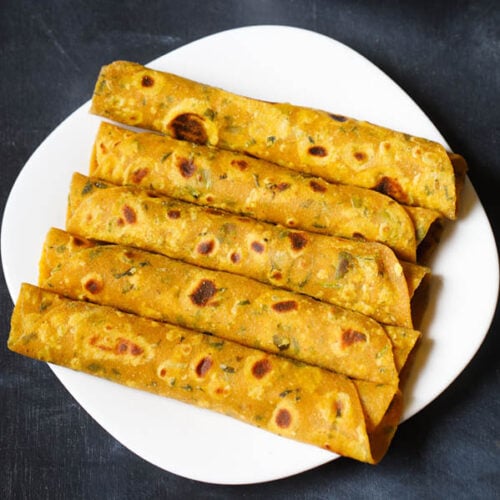
Thepla Recipe | Gujarati Methi Thepla (Multigrain)
Ingredients
- 1 cup fenugreek leaves (methi) – tightly packed
- 1 cup whole wheat flour – 120 grams
- ¼ cup gram flour (besan), 40 grams
- ¼ cup pearl millet flour (bajra flour), 40 grams
- ¼ cup sorghum flour (jowar flour) or 40 grams
- 1 inch ginger – crushed to a paste
- ½ to 1 teaspoon chopped green chillies or serrano pepper – crushed to a paste
- ½ teaspoon red chili powder or cayenne pepper
- ½ teaspoon turmeric powder
- ½ teaspoon cumin powder (ground cumin)
- ½ teaspoon Coriander Powder (ground coriander)
- ¾ teaspoon salt or add as required
- 1 tablespoon oil
- 4 to 5 tablespoon Curd (yogurt) or water for kneading or add as required
- oil as required for roasting thepla
Instructions
Kneading dough
- Rinse 1 cup methi leaves very well in water. Then drain them and chop finely.
- In a mixing bowl, take whole wheat flour, besan, sorghum flour and pearl millet flour. I have used millet flours but you can skip them if you don't have. In this case, simply add 1.25 cups whole wheat flour and ½ cup besan.
- Add all the spices and herbs.
- Add the chopped methi leaves. Mix everything well.
- Add curd (for a vegan option add very little water instead of curd).
- Mix again and knead into a dough. Don’t add water while kneading as methi leaves release water.
- Knead to a soft and smooth dough. Add more curd if needed while kneading.
Rolling to flatbreads
- Make medium sized balls from the dough.
- Take a medium sized ball and sprinkle some flour on it.
- With the rolling pin begin to roll the thepla.
- Roll them to a round of about 5 to 6 inches in diameter.
Cooking thepla
- On a hot tawa or skillet, place the thepla. Flip when one side is partly cooked, about one-fourth or half cooked. You will see some faint air pockets on the top and this is the time when you need to flip it.
- Spread oil on this side. Flip the thepla again when the second side is half-cooked.
- Now spread the oil on this side. Flip a couple of times till you get golden spots and the methi thepla is cooked evenly.
- You can also press the thepla with spatula while cooking.
- Remove and keep it in a roti basket.
- Serve methi thepla hot or warm or at room temperature.
Serving suggestions
- Enjoy methi thepla with plain curd (yogurt), lemon or Mango Pickle, Mango Chutney, or Mango Chunda.
- You can also eat these with a simple Batata nu Shaak. Methi thepla also pairs well as a side snack with Masala Chai or Ginger Chai.
Storage
- Methi thepla are best when enjoyed either right away or later the same day. They will keep well for up to 3-4 days when you make them without curd.
- So if you want to have them later after a few days, do not add curd as it will lessen its shelf life. Simply knead the dough with water. Store cooled flatbreads in an airtight container and keep at room temperature.
- They also freeze well. Simply wrap a stack of cooled methi thepla in foil before storing in an airtight freezer bag, and keep in the freezer for up to 3 months.
- Thaw in the fridge and later reheat these flatbreads either in a skillet on the stove or in the oven for just a few minutes until warm.
Video
Notes
- Flours: You can include various combinations of flours with different ratios. However, always add more whole wheat flour. With lesser amounts of wheat flour, your thepla can become chewy or hard and you won’t be able to roll the dough easily. A relevant point to be remembered is not to increase the amount of gram flour (besan) too much. This can make your methi thepla hard and dry.
- Dough consistency: The thepla dough has to be smooth, soft, and pliable. If your dough looks hard, the thepla will become dry and hard. With a soft and sticky dough, you won’t be able to roll evenly and it may tear. To correct hard dough, add a few tablespoons of curd or water and knead. For a sticky dough, add some wheat flour.
- Longer storage: If you want to make thepla for a journey or you plan to store it for some days. Then add about 3 to 4 tablespoons of oil to the flour, while you form the dough. Not only adding oil will make thepla soft but also help in preserving them for some days. Omit to add the curd (yogurt) as it decreases the shelf life of thepla.
- Spicing: For a spicy thepla add more green chilies and red chili powder. You can always add less or more ground spices and green chilies according to your preferences.
- Fats: For roasting, you may use ghee (clarified butter) instead of oil.
- Other Greens: You can make this recipe with green leafy vegetables like spinach or amaranth leaves.
Nutrition Info (Approximate Values)
This Thepla recipe from the archives first published was first published in July 2012. It has been updated on November 2024.
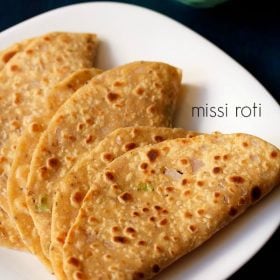


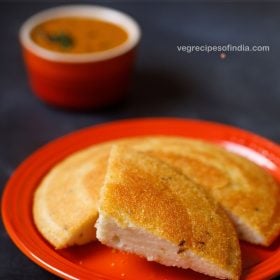



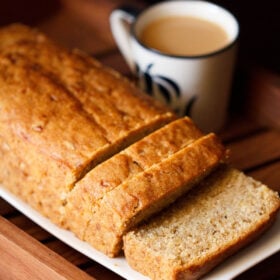









Accept my heartfelt thanks for allllll the recipes, the illustrations with key points, your enthusiasm shows in your posts and it’s infective! Love the food photography! You are indeed doing a noble job.. Not a day goes by without looking up ur version of a certain dish and making yummy food for family n friends!! Stay blessed
we are very pleased to know this asha thankyou for your kind and positive words 🙂 god bless you.
Hey, i usually use multi-grain atta so what should be the proportion of besan and atta in that case?
use the same proportion as mentioned in the recipe.
1 cup atta and ¾ cup besan, right? Sorry, I am just a beginner
no problem neha. add ¼ cup besan and 1.5 cups multi grain atta.
Good recepies
thankyou poppy.
Testy, superb recipe and one thing can we add more veggies?
you can add veggie like grated carrots, beetroots or even grated lauki.
Thanks again Dasanna. Made this for breakfast today from the methi I grew in my garden. Loved it – very tasty and wholesome. Will have to make some for a friend. Thankyou very much again!
we are pleased to know this tasneem 🙂 thankyou so much and you are welcome.
Thank you so much for helping me cook better. Whenever I want to trý some new recipe, i always search on your site.
Thank you once again!
pleased to know this sweta 🙂 thankyou for your kind words.
Hi Dassana.hope u r doing gud.Thank u for all d recipes that u post,I always cook looking at ur recipes and it always turns out to b d best.god bless u.take care
pleased to know this rose 🙂 and god bless you too. thankyou so much.
Thanks for the recipe, I didnt know we have to use besan also in Theplas.
Can we store the theplas for a long time? I have generally seen people carrying it for long vacations, etc.
besan can be added or even skipped completely. you can store them for some days.
How long do you rest the dough before baking them on the griddle?
deepti, i don’t rest the dough.
Been a South Indian idli n dosas made a regular for breakfast . Wanted to explore more n found dis . It’s amazing . Even made n took some while travelling . Thank u so much
welcome anisha. glad to know that you liked the recipe.
Hi Dassana.. i had a question.. whenever i make theplas they get chewy after cooling down.. i always cook it at high temperature and roll it thin… so I don’t think it is undercooked.. Could it be that i cook it longer??
How to usually figure out quantity of salt in the dough?? Is there a thumb rule or it comes with practice??
hi sruabhi, it could be due to the besan. try making thepla with less amount of besan or no besan. even cooking longer can give a chewiness. so you have to see which reason is contributing to this chewiness. there is no thumb rule. i usually add by andaaz.
this recipe too good . my husband enjoyed this today as I made this in breakfast. My daughter loved this thepla which is full of nutrition. Thanks a ton to you . All your recipes are very good and easy to understand and easy to follow as well. Moreover images of step by step process is like SONE PE SUHAGA. All the best .
welcome rashmi. glad to know that all of you liked the thepla recipe. thanks for sharing positive feedback on recipes.
amazing.
Made thepla yesterday, turned very very taste. Thks Dassana!
welcome mohini. glad to know this.
Hi dassana.. I love this site and your recepies.. with pictures you make the pictures clear in our minds
thanks supriya